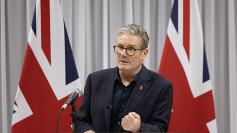A massive rocket that NASA aim to take it back to the moon by 2024 under its Artemis program aborted a test early over the weekend due to an unexpected failure.
Saturday's test was meant to last eight minutes.
However, mission control had to abort the test just 67 seconds after the thrusters were ignited. Firing all four engines of the Space Launch System (SLS) was supposed to simulate an actual launch.
The rockets needed to fire without issues for eight minutes total - roughly the time it would take for the vehicle to break from the earth's gravity.
According to NASA, mission control aborted the test after engine No. 4 had suffered a "major component failure." NASA said that it has yet to identify the cause of the failure but it is planning to investigate and fix it as soon as possible.
"Saturday's test was an important step forward to ensure that the core stage of the SLS rocket is ready for the Artemis I mission, and to carry crew on future missions," NASA administrator, Jim Bridenstine, said.
NASA said that while it wasn't able to fire the engines for the planned eight-minute duration, engineers still gained a lot of valuable data. Bridenstine said that apart from the firing, everything else was successful. He said that the team was still able to successfully do a countdown and ignite the engines without issues.
The engines that were tested over the weekend will be the same ones that will be used to launch the Orion space capsule to the moon on a future mission. NASA said that it will be taking all the time it needs to ensure the safety of the vehicle.
"The amount of risk that we can take is very, very low. We can't afford to have this vehicle fail," Bridenstine said.
If engineers are able to identify and fix the cause of the component failure, NASA is expected to do another test after one or two months. NASA said that it would take at least three-to-four weeks to regroup and prepare the engines for another test.
NASA unveiled its new SLS program more than 10 years ago. It is meant to replace the U.S.' retired Space Shuttle program. NASA hopes to use the rocket and capsule combo to conduct deep space missions, including launching to the moon, Mars, and beyond.






